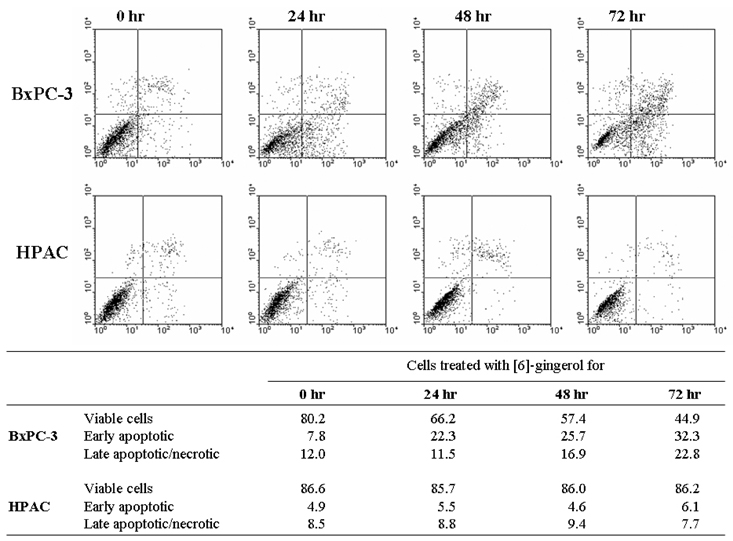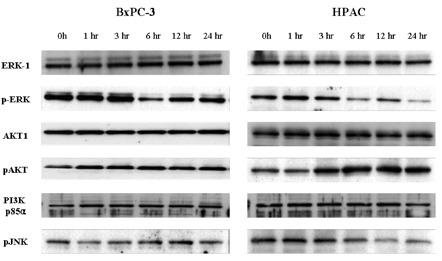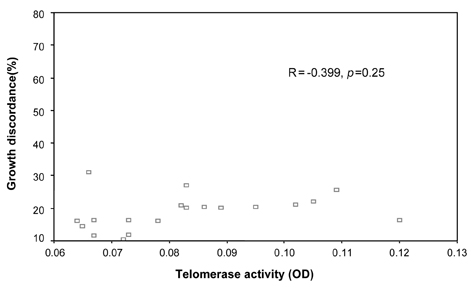Yonsei Med J.
2006 Oct;47(5):698-705. 10.3349/ymj.2006.47.5.698.
Telomerase and Apoptosis in the Placental Trophoblasts of Growth Discordant Twins
- Affiliations
-
- 1Department of Obstetrics and Gynecology, Gachon University of Medicine and Science, Incheon, Korea. ksyob@gilhos pital.com
- 2Department of Biochemistry, Graduate School of Medicine, Gachon University of Medicine and Science, Incheon, Korea.
- 3Division of Biological Science, Gachon University of Medicine and Science, Incheon, Korea.
- KMID: 1381251
- DOI: http://doi.org/10.3349/ymj.2006.47.5.698
Abstract
- In an effort to investigate the molecular basis of growth discordance in embryos that experience the same uterine environment, we compared telomerase activity and apoptosis in placental trophoblasts obtained from growth discordant twins. Between January 2003 and February 2005, placental tissue from twenty pairs of twins was obtained within thirty minutes of delivery. Eleven cases were classified as growth discordant, with birth weight discordance greater than 20%. Nine cases comprised the control group, with less than 20% discordance. Telomerase and apoptotic activities in placental trophoblasts were analyzed by ELISA and immunoblot. Statistical significance was analyzed by a paired t-test, chi- squared test, and ANOVA (SPSS ver 11.0). The average growth discordance was 26.8% in the growth discordant group and 14.4% in the control group. There were no significant differences in maternal age, week of gestation at delivery, parity, or chorionisity between the two groups. In the growth discordant group, the larger twin showed significantly higher telomerase activity (p < 0.01), whereas no significant difference was observed in the control group (p = 0.36). In addition, there was no definitive correlation between telomerase activity and the degree of growth discordance in the larger or smaller twins (R = -0.521 and -0.399, p = 0.15 and 0.25, respectively). The apoptosis proteins Bax and Bcl 2 were detected in both the larger and smaller twins in the growth discordant and control groups. There was no statistically significant difference in Bax expression between the larger and smaller twins (p = 0.25 and 0.92, respectively) for either the growth discordant or the control groups. Bcl 2 expression also showed no significant difference between groups. In Conclusion, A tendency toward reduced telomerase activity and increased apoptosis was discovered in placental trophoblasts of the smaller growth- discordant twin, possibility resulting in delayed fetal growth.
Keyword
MeSH Terms
-
bcl-2-Associated X Protein/metabolism
Trophoblasts/*enzymology/pathology
Telomerase/*metabolism
Proto-Oncogene Proteins c-bcl-2/metabolism
Immunoblotting
Humans
Fetal Growth Retardation/*enzymology/metabolism/*pathology
Fetal Development/physiology
Enzyme-Linked Immunosorbent Assay
Diseases in Twins/*enzymology/metabolism/*pathology
*Apoptosis
Figure
Reference
-
1. O'Brien WF, Knuppel RA, Scerbo JC, Rattan PK. Birth weight in twins: an analysis of discordancy and growth retardation. Obstet Gynecol. 1986. 67:483–486.2. Spellacy WN, Handler A, Ferre CD. A case-control study of 1253 twin pregnancies from a 1982-1987 perinatal data base. Obstet Gynecol. 1990. 75:168–171.3. Counter CM. The role of telomeres and telomerase in cell life span. Mutat Res. 1996. 366:45–63.4. Harley CB. Telomere loss: mitotic clock or genetic time bomb? Mutat Res. 1991. 256:271–282.5. Blackburn EH. Structure and function of telomere. Nature. 1991. 350:569–573.6. Collins K. Structure and function of telomerase. Curr Opin Cell Biol. 1996. 8:374–380.7. Izutsu T, Kudo T, Sato T, Nishiya I, Ohyashiki K, Nakagawara K. Telomerase and proliferative activity in placenta from women with and without fetal growth restriction. Obstet Gynecol. 1999. 93:124–129.8. Nishi H, Yahata N, Ohyashiki K, Isaka K, Shiraishi K, Ohyashiki JH, et al. Comparison of telomerase activity in normal chorionic villi to trophoblastic diseases. Int J Oncol. 1998. 12:81–85.9. Jung YN, Kim SK, Chung HC, Park KH, Kim CH, Cho HJ, et al. Telomerase activity in human placenta tissues: Comparison between preeclampsia with and without fetal growth restriction. Korean J Obstet Gynecol. 2000. 43:172–178.10. Kyo S, Takakura M, Tanaka M, Kanaya T, Sagawa T, Kohama T, et al. Expression of telomerase activity in human chorion. Biochem Biophys Res Commun. 1997. 241:498–503.11. Kim SG, Jung YN, Jung HC, Park KH, Kim CH, Park JH, et al. Comparison of Telomerase Activity in Human Chorionic Villi between Eutopic and Ectopic Pregnancies. Korean J Obstet Gynecol. 2000. 43:1431–1436.12. Sagol S, Sagol O, Ozkal S, Asena U. Role of apoptosis, bcl-2 and bax protein expression in premature rupture of fetal membranes. J Reprod Med. 2002. 47:809–815.13. Fortunato SJ, Menon R, Bryant C, Lombardi SJ. Programmed cell death (apoptosis) as a possible pathway to metalloproteinase activation and fetal membrane degradation in premature rupture of membranes. Am J Obstet Gynecol. 2000. 182:1468–1476.14. Cotran RS, Kumar V, Collins T. Robbins Pathologic Basis of Disease. 1999. Philadelphia: WB Saunders;1–31.15. Smith SC, Baker PN, Symonds EM. Increased placental apoptosis in intrauterine growth restriction. Am J Obstet Gynecol. 1997. 177:1395–1401.16. Gruenwald P. Environmental influences on twins apparent at birth. A preliminary study. Biol Neonate. 1970. 15:79–93.17. Corney G, Robson EB, Strong SJ. The effect of zygosity on the birth weight of twins. Ann Hum Genet. 1972. 36:45–59.18. Ramos-Arroyo MA, Ulbright TM, Yu PL, Christian JC. Twin study: relationship between birth weight, zygosity, placentation, and pathologic placental changes. Acta Genet Med Gemellol. 1988. 37:229–238.19. Bleker OP, Breur W, Huidekoper BL. A study of birth weight, placental weight and mortality of twins as compared to singletons. Br J Obstet Gynaecol. 1979. 86:111–118.20. Machin GA. Velamentous cord insertion in monochorionic twin gestation. An added risk factor. J Reprod Med. 1997. 42:785–789.21. Kim NW, Piatyszek MA, Prowse KR, Harley CB, West MD, Ho PL, et al. Specific association of human telomerase activity with immortal cells and cancer. Science. 1994. 266:2011–2015.22. Kudo T, Izutsu T, Sato T. Telomerase activity and apoptosis as indicators of aging in placenta with and without intrauterine growth retardation. Placenta. 2000. 21:493–500.23. Benirschke K, Kaufmann P. Pathology of the human placenta. 1995. 3rd ed. New York: Springer-Verlag;64–80.24. Macara L, Kingdom JC, Kaufmann P, Kohnen G, Hair J, More IA, et al. Structural analysis of placental terminal villi from growth-restricted pregnancies with abnormal umbilical artery Doppler waveforms. Placenta. 1996. 17:37–48.25. Cotran RS, Kumar V, Collins T. Robbins Pathologic Basis of Disease. 1999. Philadelphia: WB Saunders;1–31.26. Levy R, Smith SD, Chandler K, Sadovsky Y, Nelson DM. Apoptosis in human cultured trophoblasts is enhanced by hypoxia and diminished by epidermal growth factor. Am J Physiol Cell Physiol. 2000. 278:C982–C988.27. Kim CJ, Choe YJ, Yoon BH, Kim CW, Chi JG. Patterns of bcl-2 expression in placenta. Pathol Res Pract. 1995. 191:1239–1244.28. Izutsu T, Kudo T, Sato T, Nishiya I, Ohyashiki K, Mori M, et al. Telomerase activity in human chorionic villi and placenta determined by TRAP and in situ TRAP assay. Placenta. 1998. 19:613–618.29. Levy R, Smith SD, Yusuf K, Huettner PC, Kraus FT, Sadovsky Y, et al. Trophoblast apoptosis from pregnancies complicated by fetal growth restriction is associated with enhanced p53 expression. Am J Obstet Gynecol. 2002. 186:1056–1061.
- Full Text Links
- Actions
-
Cited
- CITED
-
- Close
- Share
- Similar articles
-
- A Review of the Roles of Placental Chorio nic Trophoblasts and Macrophages and Trends in Perinatal Research
- Management of discordant twin
- Trophoblast Apoptosis and BRCA1 Expression in Fetal Growth Restriction Pregnancy
- Placental Apoptosis from Pregnancies Complicated by Fetal Growth Restriction or Preeclampsia: Expression of Bcl-2, Bax and p53
- Comparison of Placental Apoptosis in Normal Pregnancy, Preeclampsia and Intrauterine Growth Restriction





